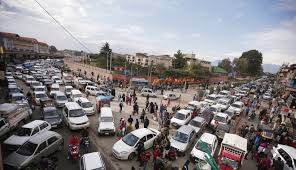NGOs engaged in road safety initiatives need to time their priorities of raising awareness, educating communities, and supporting victims of road accidents.
Street Talk
Expert Opinion

In the past few weeks, I am frequently coming across some specific videos/posts on the digital street (Facebook) showing a group of youth under the banner of a non-governmental organization (NGO) parading specific Srinagar City roads to “manage traffic”. Astonishingly, the frequency of uploading the activity videos and photo features by the NGO displays intercepting vehicles of their choice under the cover of traffic police to check vehicle documents and other essentials required to drive on roads. A peep into the activity report on the specific busy city roads posted on the digital street doesn’t reveal any dramatic impact on the ground situation as the traffic jams refuse to die and continue to present a terrific situation for commuters. It seems an activity in a hurry to record it for formality sake.
For instance, it was absurd to watch a video posted by the NGO in which a member of the NGO wearing dark sunglasses inside a school bus was displaying a first aid box containing expired medical items to school children who were being ferried to their respective homes. One fails to understand how this sort of awareness campaign is going to leave impact and help to manage traffic in a better way. It only reflected the mistimed priorities as the city and towns needed a sustainable solution to overcome the frequent grid locks and at the same time tailor innovative strategies to arrest the increasing trend of road accidents and scale it down. Launching a crackdown on school buses in the middle of busy roads only adds to the inconvenience of the general public. It would be in the fitness of things to launch a comprehensive awareness campaign for school management to make them understand about the importance of keeping their buses fit in all respects before plying them on the roads. Displaying first-aid box containing expired items to school children is a wasteful activity.
Actually, in the given scenario, the role of non-governmental organizations (NGOs) is inevitable as these organizations can play a yeoman’s role in road safety initiatives by raising awareness, educating communities, and supporting victims of road accidents. And such organizations in collaboration with government agencies and other stakeholders across the country are actively engaged in road safety initiatives.
As all of us are aware that in the present times, road safety is one of the crucial concerns, where the number of road accidents and fatalities across the country remains alarmingly high. Inadequate infrastructure, lack of awareness, reckless driving, and non-compliance with traffic rules are some of the contributing factors to the deadly mess on roads. Even as the government has been investing in the development of better roads, including construction of flyovers and underpasses, the congestion on roads leading to ugly traffic jams continues to remain a concern as the situation throws road safety to the wind. Even enforcement of road safety laws and regulations and penalties, the mess on roads remains a horrible sight to watch.
Technically speaking, the role of NGOs includes their active participation in policy discussions to develop more effective strategies, sharing of valuable inputs based on their expertise, implementing targeted interventions and also to monitor the pace of progress of road safety initiatives. One of the biggest contributions of NGOs in road safety measures is organizing community engagement programmes to encourage the participation of local residents to foster a sense of responsibility among them to adopt safe behaviors on the roads.
Framing of effective policies and strategies to streamline road safety measures with tailor-made specific interventions has its base in the collection and analysis of road safety data. This helps to identify trends, risk factors, and weak areas where targeted interventions are required. Here the role of NGOs is crucial to conduct thorough research which can guide the government towards a data-driven approach to road safety through formulation of appropriate policy interventions and stem the rot causing mess on roads.
However, it is of paramount importance for all stakeholders, especially the government agencies and NGOs to align their interventions in line with emerging technologies, with due focus on changing behavioral patterns.
Meanwhile, the role of NGOs in the union territory of Jammu & Kashmir Jammu & Kashmir in road safety measures merits a discussion owing to the unending mess on the roads where traffic jams are terrific and life-consuming accidents are happening frequently. But before that let us have a general look at the road safety scenario in the region.
Current era is called the modern period for the kind of pace technological integration has triggered even in our routine activities. The modern era has bridged distances and of course localised the global geographies. But one major area that has remained a scar on its face is the growing menace of gridlock that has been eating up our growth trajectory. Today, travelling even small distances here is an uphill task for the commuters.
Everyone is contributing to the menace. While on road, whether driving our own vehicle or using a passenger vehicle, we are always in a hurry to reach our destination at whatever cost. During the course, we play havoc with traffic rules and other safety measures, which on many occasions prove fatal. While fixing responsibility for these gridlocks, people impulsively blame traffic police. But major contributors to this traffic mess are none other than the people themselves.An office-goer who has been late for duty is quick enough to escape by blaming the traffic mess. Taking the excuse is true, but the likelihood is that he too was in fact causing the traffic jam. After all, his car also forms part of a line and is holding up the car behind. So, by definition, he does not just get stuck in a traffic jam, he produces it by defying rules and norms.
Our traffic jams have their own structures. They are not vertical alone but lateral as well and you wonder how to thread your way through. People are glad to resort to on-street parking contraventions even on busy roads and block smooth traffic movement. There is also no concept of bus stops, though many bus stops exit at various points. Passenger vehicles never stop at bus stops. It is not the driver alone to be blamed for this. But the fact is that people never wait for a passenger bus at a bus stop. The understanding between the driver and the passenger has gone trendy that they know the bus can stop anywhere anytime for him at the cost of smooth traffic movement.
Overall, the scenario reveals that traffic management is a remote idea at our place, most of the time people commit blunders or pull impolite driving maneuvers, leading to anger from other frustrated drivers. Result of this situation is road rage. This state of mind of the drivers carries a lot of risk even to the health and safety for everyone on the road. Every one of us is aware that traffic congestion is something which has serious effects on us as drivers at personal, business and societal levels. And not to speak of psychological and physical health implications these jams have on us. Actually, traffic jams are a big problem that virtually every place is grappling with and has precisely become inevitable. But at the same time, we cannot afford to lock our future and succumb to these gridlocks. We have to seriously pull ourselves out of this mess and we need to challenge conventional thinking around traffic congestion.
We can talk of wiping out the congestion on roads, but in actual terms we cannot. What we can do is to reduce the congestion and for this, we need a dynamic traffic navigation system which can help people to get through traffic faster. This doesn’t necessarily involve building roads or introducing schemes, but simply making our road-flow more efficient.
In reducing chances of a gridlock and regulating flow of traffic, it’s the attitude of drivers which can trigger change. Otherwise, it’s the attitude of drivers which is at the moment the primary cause of chaos on roads. To trigger a change in the attitude of motorists here, a proper strategy is inevitable. Our passenger transport is visibly the major player in gridlocks. If we have a close look at the behavior of these drivers we find their combination of feelings, acts, thinking and perceptions loaded with anomalies. So, the drivers responsible for traffic mess on roads need a ‘handle with care’ strategy. It’s not punishment but soft handling through proper counselling which can infuse a sense of order in them as drivers.
Here, apart from NGOs, emerges the role of qualified traffic engineers having experience with planning and designing roadways and a strong understanding of laws and regulations governing vehicular movement on the roads. Notably, traffic engineers are technically qualified to design roads that are operated in a way that ensures congestion and accidents are minimized. They are trained as a responsible resource to ensure that all types of roads are safe for drivers, commuters and pedestrians.
Precisely, the time demands professionalism in managing traffic on roads without any mess and for this, it makes sense to rope in traffic engineers for the job. In the words of an acquaintance, teaching civil engineering in a reputed engineering college, traffic engineering is a branch of civil engineering where engineers are technically trained to develop traffic engineering plans; ensure proper traffic specifications; estimate traffic levels, and traffic control; and create traffic signal reports. The best part is that traffic engineers use computer simulations to test various traffic scenarios before implementing changes on streets and highways.
(The author is a veteran journalist/columnist. He is former Head of Corporate Communication & CSR and Internal Communication & Knowledge Management Departments of J&K Bank).


